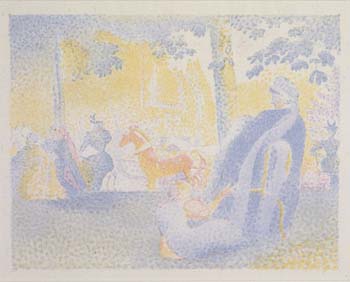Les Champs-Elysées
- 1898
- Henri-Edmond Cross (né Henri Delacroix, French 1856-1910)
- Five-color lithograph, published in Pan IV, No. 1, "The Color Revolution" 52
20.3 x 26.2 cm., 8 x 10-5/16" image
- Catherine Carter Goebel, Paul A. Anderson Chair in the Arts Purchase, Paul A. Anderson Art History Collection, Augustana College 2000.61

Essay by Kelly Volkert, Class of 2007
Cross became involved in the second phase of the Neo-Impressionist art movement, along with Paul Signac, Charles Angrand, Camille Pissarro, Maximilen Luce and Albert Dubois-Pillet. The Pointillist style of the Neo-Impressionists was composed primarily of tiny dots, typically painted in primary colors in order to optically generate secondary colors. The term Pointillism derived from the uniform touches of paint employed, called points in French (Clament and Houze xv). During his career, Cross evolved from tiny pointillist dots to larger more mosaic-like brushstrokes, akin to Fauvism (French Expressionism), which grew out of Pointillism and Post-Impressionism.
This print entitled Les Champs-Elysées (126B) is a beautiful Parisian scene reflecting the French joie de vivre (joy of living) along the fashionable Champs-Elysées. This street was one of the major boulevards constructed in the newly remodeled modern Paris, lined with fashionable shops and restaurants. It was considered a very chic area by the bourgeoisie. Since it linked the Arc de Triomphe and its turnaround with the Tuileries Gardens and the Louvre at the opposite end, it was utilized as a major thoroughfare for strollers and carriages. A nurse and child are seated in the foreground, simplified into abstracted shapes. In the background, there are many additional figures, including other seated women and a pair of horses pulling a carriage. The vertical tree trunks balance the curvilinear masses of rounded figures in order to produce compositional unity. The bright shades suggest the warm sunlight shining on the women on this idyllic day. Cross added shades of blue to intensify the grass and the trees.
A very rare opportunity presents itself in comparing this five-colored lithograph with one of its preliminary sketches entitled Au Jardin (At the Garden-126A). The drawing shows a more detailed study of a woman seated, in nearly the same position and angle as the finished print. The sketch, however, is more detailed and three-dimensional as defined through subtle color gradations and sensitive additions in colored pencil. It is interesting to note that Cross first worked from such beautifully rendered naturalistic studies, which he then abstracted into overall shapes and patterns, arranging the parts into a balanced composition and finishing it in the pointillist technique. This comparison demonstrates his steps in abstracting nature.
